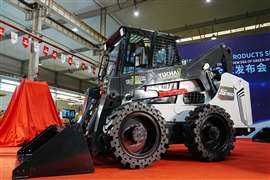Russian machinery industry in trouble
29 June 2015
Construction machinery production in Russia is close to collapse, according to a report by research company PMR, which said limited financial potential had led to “insignificant amounts” being put into research and development (R&D).
It said that this lack of investment affected new kinds of equipment and improvements to existing product ranges.
Limited productivity and high running costs had stunted the competitiveness of Russian machinery, it said, not only on world markets but also at home. Most Russian construction machinery manufacturers have been unable to face competition from foreign brands, it claimed.
In PMR’s report – Construction Machinery Market in Russia 2015 – it said that the cost advantage from lower energy prices had narrowed significantly in recent years, as Russia had been forced to reduce the gap in energy prices as a condition of joining the World Trade Organisation (WTO).
Furthermore, it said, with obsolete production facilities in most cases, Russian manufacturers increasingly had to use Western parts in their machines to be able to increase competitiveness.
PMR said that all of these factors had inevitably led to price rises for the final products, particularly in 2014 and 2015 with the plummeting Ruble making the import of components much more expensive.
It said that until 2012, when Russia joined the WTO, there had not been enough support from the government for domestic production of construction machinery, and that this had almost exclusively been apparent in the form of increases in import duty rates.
It added that since 2012, import duty rates had been reduced or maintained at existing levels but not increased.
Stimulus
PMR pointed to a major stimulus from the Russian Government in July 2014 when it banned state and municipal administrations, as well as legal entities which are 100% controlled by federal, regional and/or municipal administrations, to purchase construction machinery manufactured outside the Eurasian Economic Union.
PMR found that the ban had created only a marginal effect on production of construction machinery in Russia so far.
Imported machinery currently dominates the market, it said, adding that in many cases, the price factor was no longer a competitive advantage for Russian models when they have to compete with their Chinese equivalents. This is even after the 40 to 50% depreciation of the Ruble between early 2014 and mid-2015, and despite the fact that a 5% import duty rate is applicable to such machines.
With regard to Western brands, PMR found that even used machinery tended to be more expensive but surpassed Russian equipment in terms of ergonomics, comfort, a wider product range and quality of service.
For example, PMR found that production of excavators – still the most widely used category of construction equipment in Russia – had plummeted over the past two decades. In the early 1990s more than 15,000 excavators were assembled in Russia every year. In 2012 to 2014, the figure came to less than 2,000 a year.
Russian manufacturers have gradually been squeezed out of the market, it said. While ten years ago domestic producers accounted for more than half of the total excavator market, these companies now account for just 10 to 15%.
PMR said that the only positive figures in this landscape came from TVEX and the relatively young producer Exmash, whose production has been steadily increasing.
Foreign manufacturers
Even international manufacturers do not use production units in Russia at full capacity, said PMR. Caterpillar was the first foreign manufacturer to start production of excavators in Russia – in 2008 – and was followed by Komatsu in 2010, and by Volvo and Hitachi in 2013.
PMR said it should be emphasised that although there were plans for Caterpillar, Volvo and Hitachi’s Russian plants to produce up to 2,000 excavators per year, none of the manufacturers assembled even 200 machines in Russia in 2014.
In fact, between 2008 and 2014, Caterpillar assembled fewer than 200 excavators every year in Russia, it said. In the case of Komatsu, although its plant in Russia has a total annual production capacity of around 3,000 excavators, PMR said it had not manufactured more than 565 excavators per year since its activation in 2010.






